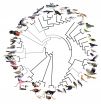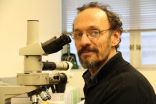(Press-News.org) Stroke is Australia's second biggest killer after coronary heart disease, but rates of a common type of stroke, intracerebral haemorrhage (ICH), appear to be falling, according to a UNSW study that is the largest of its kind in Australia.
ICH accounts for about 15% of all strokes. Close to 40% of patients will die within 30 days and significant disability is common in survivors.
The improvement in the incidence of ICH may be the result of the widespread implementation of proven prevention and treatment programs, the researchers say.
The large retrospective, observational study of NSW hospital admissions and registered deaths data found that fatal ICH had declined by an average of 2.6% per year over eight years. ICH incidence overall declined by an average of 1.6% per year.
The study involved data from 11,322 ICH patients admitted to hospital in NSW between 2001 and 2009, linked to death registrations to July 2010. The inclusion of such a large number of identified ICH cases from within a clearly defined geographical area is one of the study's strengths.
Declining ICH rates suggest better recognition and management of blood pressure is proving effective. Greater access to stroke and neurosurgical units, and advances in stroke care may also explain falling fatality rates, the researchers say.
"The risk of mortality and disability is still high after intracerebral haemorrhage, so more needs to be done, but there is evidence that the preventative measures and better stroke care put in place during the past decade are working," says UNSW Conjoint Associate Professor John Worthington, the study's author, who is based at the UNSW South Western Sydney Clinical School and the Ingham Institute for Applied Medical Research.
"This trend is encouraging. If you deliver better care through stroke and neurosurgical units, you can reduce mortality."
The study also assessed the influence of sex, age, region of birth and socioeconomic status against the incidence of ICH and found that while ICH rates are in decline overall, males, the elderly, people living in areas of greater socio-economic disadvantage and those born in parts of Oceania and Asia, had a higher risk of ICH and of dying as a result.
The study's authors estimate that hospital admissions for ICH could be reduced by about 12% if the socio-economic circumstances of the entire population matched those of the most advantaged.
INFORMATION:
The study is published online in the Journal of the American Heart Association.
Associate Professor Worthington is Medical Co-chair of Stroke Services NSW, an honorary leadership position tasked with executive decision-making regarding stroke services.
The most ambitious genetic study ever undertaken on bird evolution has found that almost all modern birds diversified after the dinosaurs became extinct 66 million years ago.
"The popular view until now has been that the extraordinary diversity of birds began during the dinosaur age but we found little support for this," said Associate Professor Simon Ho, from the University of Sydney who led a major component of the research looking at evolutionary timescale.
An international collaboration of scientists worked for four years to sequence, assemble and compare the ...
People with a high level of education who complain about memory lapses have a higher risk for stroke, according to new research in the American Heart Association journal Stroke.
"Studies have shown how stroke causes memory complaints," said Arfan Ikram, M.D., associate professor of neuroepidemiology at Erasmus University Rotterdam in The Netherlands. "Given the shared underlying vascular pathology, we posed the reverse question: 'Do memory complaints indicate an increased risk of strokes?'"
As part of the Rotterdam Study (1990-93 and 2000-01), 9,152 participants 55 ...
Children with public insurance waited longer after initial evaluation for sleep-disordered breathing (SDB) to undergo polysomnography (PSG, the gold standard diagnostic test) and also waited longer after PSG to have surgery to treat the condition with adenotonsillectomy (AT) compared with children who were privately insured, according to a report published online by JAMA Otolaryngology-Head & Neck Surgery.
Low socioeconomic status (SES) is a barrier to quality care and improved health outcomes. SDB is a spectrum of sleep disruption that ranges from snoring to obstructive ...
EAST LANSING, Mich. - It's well known that chemotherapy helps fight cancer. It's also known that it wreaks havoc on normal, healthy cells.
Michigan State University scientists are closer to discovering a possible way to boost healthy cell production in cancer patients as they receive chemotherapy. By adding thymine - a natural building block found in DNA - into normal cells, they found it stimulated gene production and caused them to multiply.
The study can be found online in the journal Molecular Cell.
"In most cases, cancer patients who receive chemotherapy lose ...
MADISON, Wis. -- Frederick Crane was a researcher under David E. Green in the mid-1950s, during the early days of the University of Wisconsin-Madison Enzyme Institute, when he made his defining discovery.
The lab group was on a mission to determine, bit by bit, how mitochondria -- the power plants of cells -- generate the energy required to sustain life. What Crane found, a compound called coenzyme Q, was a missing piece of the puzzle and became a major part of the legacy of mitochondrial research at UW-Madison. But it was no accident.
"It was the result of a long ...
Montréal, December 11, 2014 - Researchers in Montréal led by Jacques Drouin, D.Sc., uncovered a mechanism regulating dopamine levels in the brain by working on a mouse model of late onset Parkinson's disease. The study, conducted in collaboration with Dr. Rory A. Fisher from the Department of Pharmacology at the University of Iowa Carver College of Medicine, is published online today by the scientific journal PLoS Genetics.
Using gene expression profiling, a method to measure the activity of thousands of genes, researchers investigated dopaminergic neurons in ...
WEST LAFAYETTE, Ind. - A new method that creates large-area patterns of three-dimensional nanoshapes from metal sheets represents a potential manufacturing system to inexpensively mass produce innovations such as "plasmonic metamaterials" for advanced technologies.
The metamaterials have engineered surfaces that contain features, patterns or elements on the scale of nanometers that enable unprecedented control of light and could bring innovations such as high-speed electronics, advanced sensors and solar cells.
The new method, called laser shock imprinting, creates shapes ...
A new study led by researchers at University of California, San Diego School of Medicine finds that the brains of obese children literally light up differently when tasting sugar.
Published online in International Journal of Obesity, the study does not show a causal relationship between sugar hypersensitivity and overeating but it does support the idea that the growing number of America's obese youth may have a heightened psychological reward response to food.
This elevated sense of "food reward" - which involves being motivated by food and deriving a good feeling ...
PORTLAND, Ore. -- A large international group of scientists, including an Oregon Health & Science University neuroscientist, is publishing this week the results of a first-ever look at the genome of dozens of common birds. The scientists' research tells the story of how modern birds evolved after the mass extinction that wiped out dinosaurs and almost everything else on Earth 66 million years ago, and gives new details on how birds came to have feathers, flight and song.
The consortium of more than 200 scientists is publishing its findings nearly simultaneously this week ...
A team of researchers led by North Carolina State University has found that stacking materials that are only one atom thick can create semiconductor junctions that transfer charge efficiently, regardless of whether the crystalline structure of the materials is mismatched - lowering the manufacturing cost for a wide variety of semiconductor devices such as solar cells, lasers and LEDs.
"This work demonstrates that by stacking multiple two-dimensional (2-D) materials in random ways we can create semiconductor junctions that are as functional as those with perfect alignment" ...

